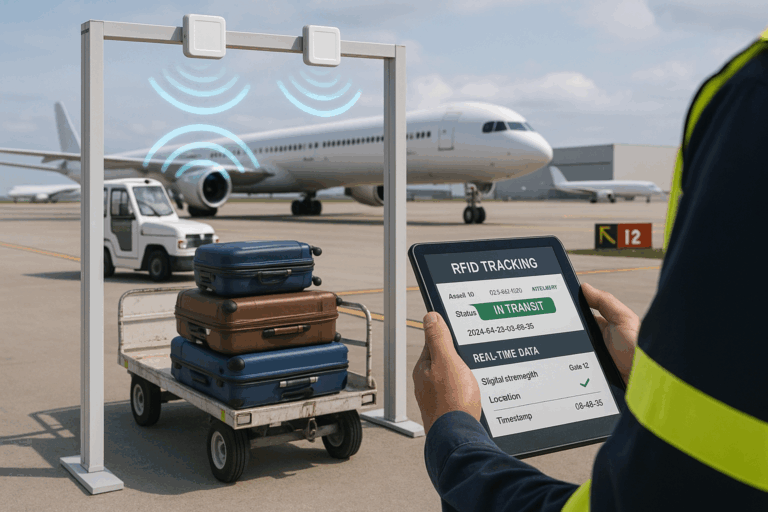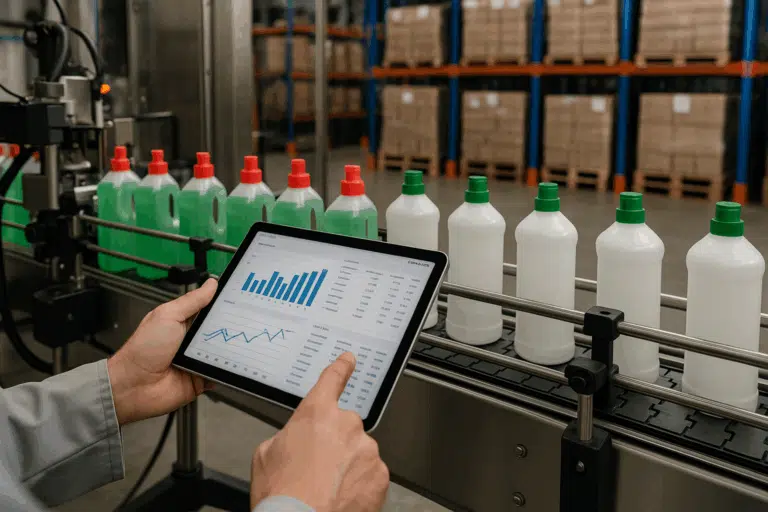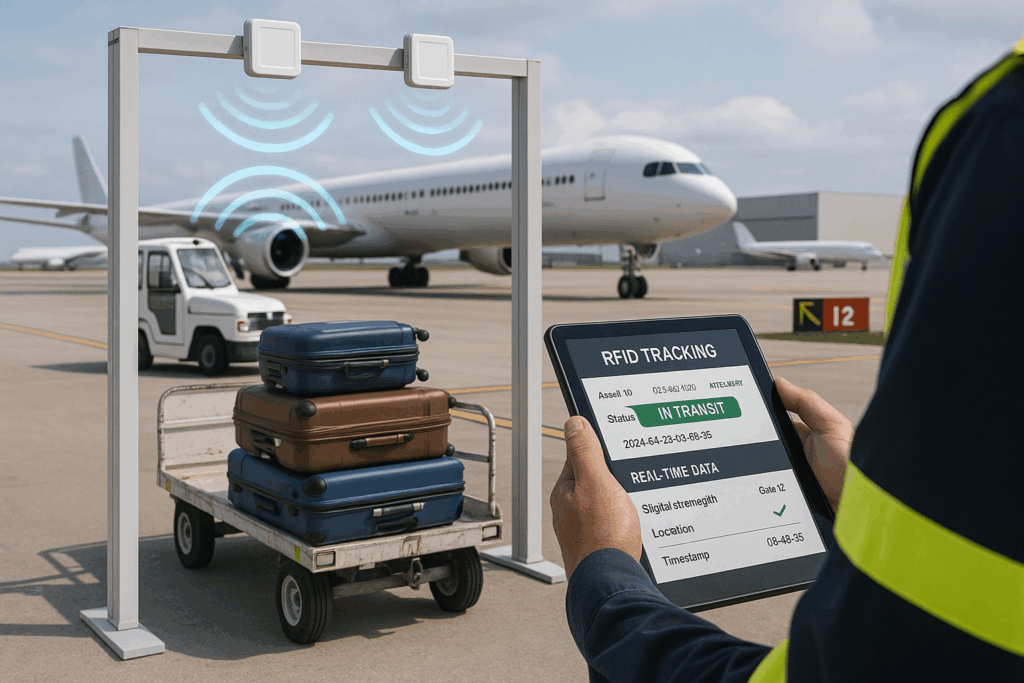At The CPCON Group, we’ve seen the big change RFID makes in control and tracking. We ask: How is RFID technology transforming the foundations of supply chain management, while changing how work is done? Our experience shows that RFID not only makes work smoother but also adds new challenges.
RFID speeds up tracking and keeps counts more accurate. It helps in getting products to customers sooner. This new way of doing things also changes how we look at costs. With RFID, we can do many tasks faster and with less people. This means up to 60% fewer tasks for people to do by hand.
But we need to look at both sides of using RFID in supply chains. Let’s explore the role of RFID in supply chain management. We’ll see how it can really help your business.

Table of Contents
ToggleKey Takeaways
- RFID integration with WMS significantly boosts product tracking and inventory counting speed, ensuring more accurate warehouse operations.
- Enhancements in product availability and asset visibility due to RFID technology contribute to a leaner, more responsive supply chain.
- Rising efficiency levels and reduced labor costs underscore the transformative impact of RFID on traditional supply chain management.
- While RFID introduces notable advantages, it also raises considerations regarding the future of human labor and the nuances of technology adoption.
- Despite its short-range limitations, strategic implementation of RFID can deliver a robust return on investment over the long term.
In the end, we see RFID as a real game-changer. But, to really get the most out of RFID, you need to think carefully about how to use it. If you want to see how RFID can make your supply chain better, contact one of our experts. Let’s make your future supply chain more efficient and cost-effective together.
Understanding RFID’s Role in Modern Supply Chain Management
The CPCON Group is at the forefront of using RFID in supply chain management. We saw its game-changing potential early on. RFID, short for Radio Frequency Identification, marries the digital and physical aspects of moving goods. This RFID definition in supply chain management means using electromagnetic fields to tag and track items. This process sharpens how operations run.
Using RFID tech has really lifted the lid on how we handle stock and assets. By putting RFID tags on items, we get a much clearer picture of the supply chain. Scanning multiple items at once is now possible, making things move quicker and with fewer errors. Plus, with RFID, tags are like diaries, updated with new info as things make their way through the chain. This is a big help in complex settings.
We use RFID at our company to make planning delivery routes and handling goods better. Thanks to knowing where items are in real time, our logistics team can tweak routes, speed up deliveries, and spot-fix problems fast. This is key in keeping role of RFID in logistics relevant. It not only helps the supply chain work better but also makes transporting goods smoother, cutting down on delays and mix-ups.
Here’s how RFID has helped our logistics clients specifically:
| Feature | Benefits |
|---|---|
| Inventory Accuracy | Enhances real-time data on stock levels, reducing overstocks or stockouts. |
| Operational Efficiency | Speeds up check-outs and inventory counts, leading to optimized labor use and reduced costs. |
| Cost Reduction | Decreases manual data entry needs, streamlining operations. |
| Loss/Theft Reduction | Provides continuous visibility into the movement of goods, reducing the chances of loss or theft. |
| Integration with IoT | Enhances real-time monitoring and control of assets, improving overall asset management. |
We invite those keen to learn more about how RFID can bring big benefits to their supply chains to reach out. Our ready team can introduce solutions that will revolutionize your logistical operation. We leverage top-notch RFID technology for better precision and effectiveness.
Advantages of RFID in Supply Chain Management

At CPCON, we know the advantages of RFID in supply chain management. It makes tracking much more precise and operations run smoother. We have found that RFID changes how we look at logistics, inventory, and asset tracking. It gives us up-to-the-minute and reliable data.
1. Enhanced Tracking and Real-Time Data Collection
We use RFID to collect data in real time. This gives us an instant look at where assets are and when they move. We can track products in warehouses and across the supply chain easily.
This lets us quickly meet any logistical needs and manage inventory better. RFID also lays the groundwork for using predictive analytics. This makes forecasting inventory and planning easier.
2. Reducing Human Error and Enhancing Accuracy
RFID gets rid of many errors by automating how we record inventory data. It can read many tags at once without seeing them. This boosts how accurate our supply chain works are.
With RFID, we have fewer mistakes when handling orders. Goods are misplaced less, and our counts are more accurate. This level of accuracy means the right products are always where they should be. This makes our operations more reliable.
3. Efficiency in Inventory Management and Asset Control
Using RFID has completely changed how we deal with inventory and assets. It makes counting and managing items easier and more precise. We get real-time updates and can report accurately. RFID also helps us keep track of valuable items. Things like machinery, vehicles, and key materials are always under our watch. This boosts security and use rates. Such an approach not only improves supply chain efficiency, but also makes our logistics more scalable and adaptable.
If you’re looking to upgrade your supply chain, get in touch with our CPCON team. We can help you see how RFID can modernize your management strategies.
RFID Defined: Bridging the Digital and Physical in Supply Chains
At CPCON, we see that RFID technology definition goes further than just finding things. It’s key for digital transformation with RFID. It bridges the divide between physical items and the digital world in the supply chain. RFID uses radio waves to share data between a tag and a reader, improving how we manage data and connect with digital systems. This boosts efficiency and visibility without needing a clear line of sight.
Using RFID in supply chains needs careful thought for success. We pick the right tags, considering how they handle different environments and exposures. They should resist temperature, humidity, and other challenges along the supply chain. This careful selection ensures everything works smoothly.
| Feature | Description |
|---|---|
| Frequency Bands | Commonly used RFID frequencies include Low Frequency (LF), High Frequency (HF), and Ultra-High Frequency (UHF), each suited to different tracking environments. |
| Tag Form Factors | Variety in shapes and sizes such as round, square, and rectangular to fit diverse applications. |
| Read Range | Crucial for determining how far an RFID reader can be from a tag while still retrieving accurate data. |
| Data Storage | Variation in capacity among RFID tags influences the volume and type of information they can store. |
| Security Features | Encryption and password protection to ensure secure data handling in sensitive environments. |
Implementing RFID can greatly boost how well things work in our industry. It reduces errors and provides real-time data for better decisions. These benefits are important for businesses in many fields. They help keep a competitive edge through better inventory and asset management.
Considering RFID for your business? Or want to upgrade existing systems? Talk to our CPCON experts. We have the know-how and solutions needed for RFID in supply chain management. Let’s work together to adopt these innovations for better logistical operations.
Operational Insights: How is RFID Used in Supply Chain Management
At CPCON Group, we’ve seen how RFID changes supply chain management. It’s not just a tool; it reshapes how businesses operate. RFID is used in tracking inventory and streamlining the movement of items. It makes warehouse management, logistics, and shipping processes more efficient.
Warehouse Inventory Management
Using RFID makes managing inventory much better. In our warehouses, each item or pallet gets logged and tracked fast and accurately. This makes stock checks quicker and more precise. As a result, warehouses become better organized. We use space and resources more wisely, showing the value of RFID in managing stock.
Distribution and Logistics Optimization
RFID helps make logistics smarter and asset management better. By tagging trucks and containers, operations in our distribution chains run smoother. RFID offers key data for planning routes and tracking assets in real-time. This improves how well logistics work. It lowers wait times and fuel use, making operations greener and more cost-effective.
Automated Receiving and Shipping Procedures
RFID changes how we receive and send out goods. It works with machines to move products without human help. This cuts down on mistakes and keeps inventory records updated without delay. In transportation, RFID eases moving goods. This means smoother transitions across transport types, which makes customers happier.
By using RFID in many supply chain areas, we at CPCON improve operations. RFID raises efficiency and prepares us for future inventory and logistics changes. We suggest all businesses consider RFID technology. This will transform how you work. For help with adding RFID to your supply chain, talk to our experts today. Let’s make your operations excellent together.
Quantifying the Benefits of RFID in Supply Chain Management

The CPCON Group has seen how RFID improves supply chains. It’s important to measure how much this tech helps, as it leads to big savings. These savings reach down to our earnings.
RFID makes data collection automatic, needing less human work. This cuts out many errors. It also helps keep track of supplies accurately and makes customers happy by ensuring items are in stock. This is key for keeping up in today’s fast markets.
| Area of Impact | Improvement | Related Metric | |
|---|---|---|---|
| Labor Efficiency | Reduced time in tracking incoming/outgoing products | 20% time savings | |
| Asset Management | Decreased loss of assets | 15% reduction in asset misplacement | |
| Production Control | Enhanced component tracking | 25% decrease in production delays | |
| Compliance and Safety | Improved identification and management of faulty equipment | 30% faster resolution of compliance issues | |
| Cost Savings | Effective inventory management leads to reduced overhead costs | 18% decrease in inventory holding costs |
RFID isn’t just about tracking items. It also betters the whole buying process. It makes sure deliveries are right and fast. This helps us stay ahead of the competition.
The best part is that RFID not only solves today’s problems. It also makes our work ready for the future. At CPCON, we take pride in using RFID for such huge wins in supply chain.
Are you ready to see how RFID can help your business save big and run smoother? Reach out to our experts. Let’s use the latest in RFID to upgrade your supply chain management.
RFID Tags: The Unsung Heroes in Supply Chain Efficiency
At CPCON Group, we know how valuable RFID tags are in supply chain management. Our experience has truly shown their huge impact on making things run smoothly. Today, we’ll look at the different types of RFID tags and how they help refine supply chains.
Types of RFID Tags and Their Application
There are two main types of RFID tags: passive and active. Passive tags are popular because they are cheap and easy to use. They get power from the reader’s signal to send data. This is great for tracking lots of items, like in stores or factories, saving money.
Active RFID tags have their own battery, so they can send data farther. They’re best for tracking big items or goods moving long distances in the supply chain.
RFID has changed the game in supply chain management by making items visible and inventory accurate. Using RFID tags means we can track items in real-time from when they’re made to when they’re delivered. This cuts down on mistakes and delays a lot.
Integration with Warehouse Management Systems
RFID and warehouse management systems (WMS) working together is crucial. It makes info flow smoothly and accurately through the supply chain. This mix helps warehouses manage stock better, cut costs, and meet market demands quicker.
It also speeds up and makes order processing more accurate. This makes customers happier and more satisfied. At CPCON Group, we’re all about using RFID to make warehouses work better.
In short, RFID tags are key to making supply chains work better. They are widely used in all sorts of businesses, from stores to factories. For businesses wanting to improve their supply chain, using the right RFID technology is essential. Talk to our team at CPCON Group to see how RFID can upgrade your supply chain.
Pros and Cons of RFID in Supply Elements

At CPCON, we’ve made great use of RFID to make supply chains work better. RFID technology has changed the game for us, making everything smoother. But, using RFID does have its own problems and it’s not cheap.
Pros: Streamlining Processes and Reducing Costs
Using RFID in the supply chain boosts efficiency a lot. It automates collecting data, cutting down on mistakes and making data more accurate. This speeds things up and saves money. For example, at the UPMC Distribution Center, RFID makes boring tasks automatic. This saves a lot on wages.
Also, RFID advantages in supply chain mean better control of inventory. Companies can see their stock in real-time, which is great for keeping everything running smoothly and keeping customers happy. It makes sure stocks are filled up on time, and too much stock doesn’t pile up, saving even more money.
Cons: Considerations for Cost and Implementation
But, using RFID means spending a lot upfront. Tags and readers can be expensive. Active tags, which are great because they can be read from far away, can cost from $5 to $15. And there’s the cost of keeping everything working properly.
There’re also issues like signals interfering with each other and making sure everything works together. Dealing with these troubles might need more hardware or software, which just adds to the costs.

It’s important to know both the good and the bad about RFID. At CPCON, we’re here to help you understand how to use RFID well and avoid its downsides.
If you think RFID might help your supply, get in touch with us for help and advice. We want to help you use RFID in a way that improves your business, without unnecessary risks.
Exploring RFID Applications in Diverse Supply Chain Scenarios
At CPCON Group, our work has uncovered that using RFID boosts efficiency in supply chains. This is true in many areas, from making products to selling them in stores. RFID changes how businesses manage their goods, making improvements across the board.
RFID versatility in supply chains makes it a key tool in today’s logistics. It improves how we track products and ensures orders are correct. RFID adapts to meet many supply chain needs, making it essential in supply chain operations.
| Industry | RFID Use Case | Impact |
|---|---|---|
| Retail | Inventory Accuracy | Improves stock visibility and customer experience |
| Pharmaceutical | Drug Tracking | Ensures compliance and safety |
| Manufacturing | Asset Tracking | Reduces downtime and improves asset utilization |
| Logistics | Real-time Data Capture | Enhances routing efficiency and delivery speed |
Using RFID in supply chain management lets companies like us make smarter choices. It reduces costs and helps grow businesses. The precision of RFID in tracking assets is key in complex markets.
Contact CPCON Group for expert advice on how RFID can propel your business forward.
RFID’s Impact on Product Handling: A Game Changer?
The CPCON Group uses RFID to revamp many industries. This tech automates tasks and tracks products like never before. With RFID tags on items, we can watch them every step of the way. This makes operations more reliable and clear.
Our work with RFID has shown big improvements in handling tasks and cutting mistakes. Real-time tracking is key in places like the car and healthcare fields. There, precision matters a lot. For example, in cars, we use RFID to follow parts closely in every step, from making to selling.
RFID is also big in shipping. By tagging pallets, it checks on their travel conditions. This is super important in shipping drugs, where the right environment is crucial for their effect and safety.
Also, RFID makes shops run better. Stores like Walmart and Macy’s use it for better stock. This has made shoppers happier, thanks to more reliable product checks.
At The CPCON Group, we use RFID to make supply chains smoother and add value to our clients. We can improve how you track and manage products too. Just reach out to us to see how our RFID ideas can help your business.
| Industry | Benefit |
|---|---|
| Retail | Improved inventory accuracy and customer satisfaction |
| Logistics | Optimized transport conditions tracking |
| Healthcare | Enhanced tracking of medication and medical equipment |
| Automotive | Full traceability in manufacturing and assembly |
Innovations in RFID: Pushing the Envelope of Supply Chain Management
At Grupo CPCON, we see how RFID is changing supply chains. For 25 years, we’ve been using new RFID tech, teaming it up with stuff like AI and IoT. This mix makes handling inventory and assets way easier.
Next-Generation RFID Solutions
RFID and new tech are big steps forward for smarter, better work. With RFID in IoT, we can watch and manage things closely. Special RFID tags can take a beating and track important items, like parts for buildings, very precisely. It helps us finish big projects on time and exactly right.
Integration with Emerging Technologies
Putting RFID together with AI makes systems that can predict needs and improve how we work. For example, on a big job, using RFID and 4D modeling together helped us avoid hold-ups. This smart mix of RFID and AI keeps the flow of work smooth and on point.
RFID and AI are more than just tools. They can help the environment and save money. For instance, our work in SHReDI uses RFID to make Industry 5.0 greener. The goal is to cut down e-waste and protect the earth while saving money in making things.
| Aspect | Before RFID Integration | After RFID Implementation |
|---|---|---|
| Inventory Accuracy | Approx. 74% | Up to 99% |
| Operational Downtime | Frequent | Significantly Reduced |
| Cost of Operations | Higher due to inefficiencies | Reduced by up to 30% |
| Envrionmental Impact | High | Reduced with Sustainable Practices |

To make the most of RFID and new tech in your work, we’re here to help at Grupo CPCON. Let us show you how top-level RFID solutions can revolutionize how you manage assets. Contacting us could be the best move for your business.
Navigating the Disadvantages of RFID in Supply Chain Management
CPCON has seen the upsides and downsides of RFID in supply chains. The technology can make operations smoother and efficient. But, we must also deal with its challenges and risks.
Challenges often come from technical and size barriers. For example, RFID can struggle with metal or liquids, making it hard to use in some settings. The choice of tag and reader frequencies can also affect how well RFID works.
- High initial setup and maintenance costs can deter smaller enterprises.
- Lack of standardization across global markets might complicate international operations.
- Privacy concerns arise as tags can sometimes be read post-purchase, necessitating stringent data security measures.
We must address these issues as they impact RFID’s growth. Even though it can change how we manage inventory, these obstacles can slow the technology’s spread.
Knowing about RFID’s challenges lets us help our clients wisely. We can suggest ways to use RFID that avoid or lessen these drawbacks. This way, clients get the best of both worlds – more visibility and efficiency without the troubles.
If you’re thinking about using RFID or want to improve your current setup, talk to our experts. They can offer advice and help, tailoring solutions to your needs. This ensures you get the most from RFID while addressing its weak points.
The Future Trajectory of RFID in Supply Chain Optimization
At The CPCON Group, we watch the growth of RFID in logistics and supply chains. This technology keeps getting better, showing its high value and potential. The trend shows it will keep improving, bringing more advanced solutions.
Projected Developments in RFID Technology
Experts see a future for RFID where it’s deeply integrated and advanced. Responsive RFID systems will become cheaper and more powerful. They will also have longer range and process data faster.
These changes are key for adapting to supply chain needs. Businesses will use RFID to stay ahead by improving their operations. When RFID joins forces with IoT and AI, it opens doors to smart supply chain solutions.
Anticipating Changes in Supply Chain Demands
RFID is becoming more vital, especially for tracking valuable assets and managing inventory. It thrives in fast-paced markets and meets changing consumer needs head-on. Its ability to keep up is pivotal to enhancing supply chains.
RFID is changing the game in supply chain management, fostering new approaches and growing incomes for businesses. It enhances tracking, boosts safety, and cuts down on waste, showing just a glimpse of its full potential.
At The CPCON Group, we’re leading in bringing these RFID advancements to clients. We are ready to help businesses face the evolving demands of supply chains. With our help, making the jump to the future of supply chain management is smooth.
Contact us today to see how your business can get ahead with RFID’s upcoming benefits. Take on the challenges of the market with our guidance.
Conclusion: Weighing the Pros and Cons for RFID Investment
Over 25 years, The CPCON Group has seen how RFID in supply chain management is vital. Nine out of ten companies say SCM is key to their success. By adding RFID systems, you can lower your labor costs, especially in light distribution tasks.
This can save you a lot of money. For example, in the U.S., the retail industry loses $70 billion a year because of SCM issues. So, it’s clear that RFID can help fight this loss.
When thinking about investing in RFID, we should consider both its benefits and its challenges. A good plan for using RFID can lead to less errors and better inventory accuracy, which can rise by up to 13% in retail. Also, it moves your business into tracking assets in real time.
But, there are important areas to consider. Things like privacy, security, sustainability, and having the right infrastructure matter a lot. They must match your business’s values and abilities.
The CPCON Group is here to help you understand RFID better. We suggest talking to one of our RFID experts. They can explain how custom RFID solutions can improve your inventory control and logistics. Our goal is to provide you with the best support and data to strengthen your SCM, making it as strong and flexible as needed.
Whether your RFID plans are small or large, having the right partner is crucial. By working with us, you can enhance your supply chain and move towards a brighter future with RFID.
FAQ
What are the main advantages of RFID in supply chain management?
RFID tech boosts tracking and data collection in supply chains. It cuts down on human errors and improves inventory records. This tech makes inventory and asset control more efficient, which helps the entire supply chain work better.
How does RFID technology work in supply chain management?
RFID uses radio waves to send data from tags to a reader. This tracks products in real time as they move through the supply chain. It makes managing inventory and logistics run smoothly.
What roles do RFID tags play in the warehouse management?
RFID tags keep inventory levels accurate and up to date. They make stocking, picking, and shipping faster and more accurate. Workers can scan items quickly, even without seeing them, helping warehouses run better.
Can RFID technology integrate with existing warehouse management systems (WMS)?
Yes, RFID can work with WMS systems seamlessly. It updates inventory automatically and records all stock movements in real-time. This keeps warehouse operations running smoothly.
What are some of the operational benefits of using RFID in distribution and logistics?
RFID improves distribution and logistics by providing important data for planning routes, managing assets, and monitoring. This technology decreases delays and errors in transit. It also helps use assets better.
Are there any disadvantages to implementing RFID in supply chain management?
RFID can be costly to start and needs special equipment. It might face issues with metals or liquids. Integrating it with current systems can be hard. There are privacy and data security concerns too.
In what ways are RFID and emerging technologies like IoT and AI being integrated?
RFID is joining forces with IoT and AI for smarter supply chains. This combo offers better data analysis, predictive maintenance, and automatic decision-making. It aims for more efficiency and cost reductions in the long run.
What future developments can we expect in RFID technology for supply chain management?
We can look forward to cheaper, eco-friendly RFID tags and deeper IoT integration. These advancements will enable better data analytics with AI. Standardization and more use could make supply chains more resilient and flexible.
Source Links
- https://www.techtarget.com/searcherp/tip/7-benefits-of-RFID-in-supply-chain-management-and-logistics
- https://veridian.info/inventory-management/
- https://www.encstore.com/blog/5224-pros-and-cons-of-rfid-in-warehouse-and-supply-chain-management
- https://lowrysolutions.com/blog/the-impact-of-rfid-on-the-future-of-transportation-logistics/
- https://procure4marketing.com/the-role-of-rfid-technology
- https://www.ijimt.org/papers/546-CM909.pdf
- https://www.fronetics.com/rfid-and-its-effect-on-supply-chain-management/
- https://radiantrfid.com/blog/rfid-in-supply-chain-management/
- https://www.skubiq.com/blog/key-benefits-of-rfid-in-supply-chain-management-and-logistics/
- https://rfid.averydennison.com/en/home/explore-rfid/rfid-technology-basics.html
- https://valutrack.com/valutrack/what-is-rfid/
- https://journal.oscm-forum.org/journal/journal/download/20210606173959_Paper_3_Vol._14_No_._3,_2021R_.pdf
- https://checkpointsystems.com/blog/rfid-supply-chain-management/
- https://assetvue.com/rfid-supply-chain/
- https://surgere.com/blog/rfid-in-supply-chain-management-explained/
- https://zignify.net/rfid-is-it-changing-the-future-of-logistics-and-supply-chain-management-is-it-still-useful/
- https://link.springer.com/chapter/10.1007/978-3-7908-2148-2_54
- https://myhfa.org/rfid-technology-is-critical-for-inventory-management-effectiveness/
- https://fastercapital.com/topics/benefits-of-rfid-technology-in-supply-chain-management.html
- https://www.aeologic.com/blog/rfid-use-for-supply-chain-benefits-uses-and-future-trends/
- https://fastercapital.com/topics/how-does-rfid-technology-work-in-supply-chain-management.html
- https://aratum.com/perspective/rfid-in-warehouse-management-the-pros-and-cons/
- https://www.camcode.com/blog/using-rfid-for-inventory-management-pros-and-cons/
- https://www.extensiv.com/blog/rfid-warehouse-management
- https://link.springer.com/10.1007/978-3-030-89822-9_109-1
- https://cpcongroup.com/how-to-automate-supply-chain-management-with-rfid-and-nfc-solutions/
- https://xerafy.com/rfid-in-supply-chains/
- https://www.teklynx.com/en/blog/industries-leverage-RFID-for-better-traceability
- https://cpcongroup.com/modernizing-your-supply-chain-management-with-rfids-from-manual-effort-to-data-driven-decisions/
- https://disk.com/resources/integrating-rfid-technology-into-warehouse-operations/
- https://www.mortenson.com/newsroom/jovix-tracking-system
- https://engineering.oregonstate.edu/all-stories/closing-loop-electronic-waste-rfid-technology
- https://cpcongroup.com/rfid-automated-tool-tracking-mro/
- https://checkpointsystems.com/blog/inventory-management-with-rfid/
- https://www.infizo.com/stock/blog/rfid-inventory-tracking-pros-cons
- https://www.linkedin.com/pulse/rfid-supply-chain-management-system-market-size-1lyrf/
- https://learn.saylor.org/mod/book/tool/print/index.php?id=61457
- https://www.logiwa.com/blog/rfid-supply-chain
- https://ro.uow.edu.au/cgi/viewcontent.cgi?article=1104&context=infopapers
- https://www.theappfounders.com/blog/using-rfid-for-inventory-management/



























